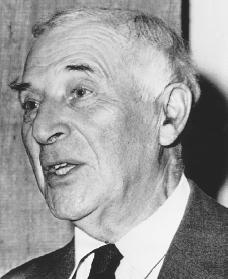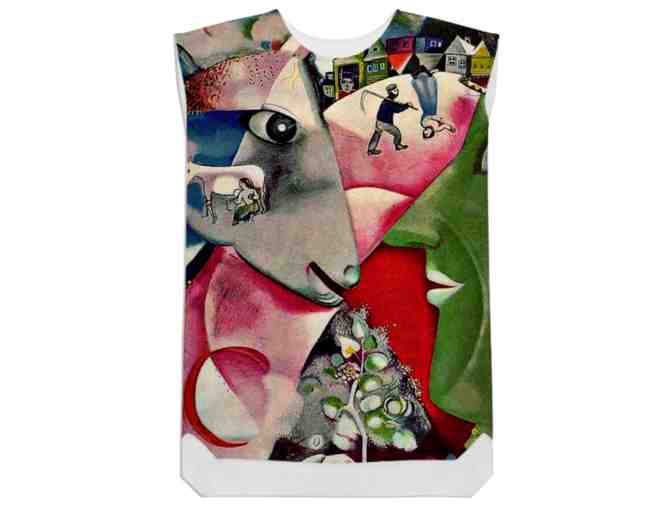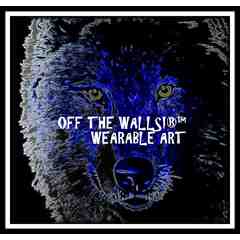Art Masters' Dresses!
"I AND THE VILLAGE" by Marc Chagall: Silky, Versatile Art Shift Dress!
- Item Number
- 1620
- Estimated Value
- Priceless
- Opening Bid
- 125 USD
Item Description
Timeless! A silky, flowing, comfy, "Go to ESSENTIAL" in every lady's wardrobe! How can YOU wear this wearable art? Let's try to count the ways!
Show off those beautiful legs and float through any event in artified style that will, definitely, get YOU noticed! or... Throw on a pair of jeans, leggings, or leather pants and simply "strut" this work of art anywhere you go!
The possibilities are endless and totally up to YOU!
TIMELESS CLASSIC AND ECO-FRIENDLY TOO! "The Shift Dress" Collection begins! Easy to wear and accessorize; perfect for traveling too! Made of Eco Friendly TENCEL fabric! (ART WORK FEATURED ON BOTH SIDES!)
ART WORK will cover the entire front and back / The backside will mirror the front / Side seam pockets and an uneven hem / Body is 100% tencel
Available Sizes: X-Small- X Large
ABOUT THE FABRIC: Tencel Clothing:
Soft, fluid, natural.
In the fabric world, Tencel is known for its "drape". It flatters the human form. The look is luxurious and refined. This new fiber also represents a milestone in the development of environmentaly sustainable textiles.
Tencel is a natural, man-made fiber. It is the trade name for the generic fiber Lyocell.
Comfortable. Similar to rayon in feel. Soft, breathable, lightweight and comfortable.
Lasting. Shrink-resistant, durable and easy to care for. It is an exceptionally strong fiber, both wet and dry.
Color rich. Tencel was created with color in mind, because of the fibers' high absorbancy. The fabrics can be dyed to high quality standards.
Easy to maintain. Tencel garments are easy to pack, resist wrinkling and dry quickly. Most are machine washable, although different garment constructions may have specific cleaning requirements.
Natural. Made from the natural cellulose found in wood pulp. The fiber is economical in its use of energy and natural resources, and is fully biodegradable.
RETAIL LIST PRICE: $300.00-399.00
CUSTOM MADE just for YOU!
Allow up to 6 weeks for delivery.
UPS International Shipping to us, then re-packaged and sent out to winners via Federal Express.
NOTE: THIS ITEM IS OFFERED EXCLUSIVELY FOR A LIMITED TIME ONLY, AT BELOW WHOLESALE COST!
**WHEN YOU BID OR BUY THIS OFFERING, ART4GOOD FOUNDATION WILL MAKE A DONATION TO SUPPORT:
STAND UP TO CANCER
INSURED FEDERAL EXPRESS SHIPPING: $39.95 *International Shipping involved
Click here TO SEE ALL Wearable Art Items on Auction NOW!
Donated By:
Item Special Note
ABOUT THE ARTIST:
Russian painter Marc Chagall was one of the great masters of the School of Paris. He was also praised as an influence on surrealism, a twentieth-century artistic movement that expressed the subconscious in wild imagery.
An inspired childhood
Marc Chagall was born Moishe Shagal on July 7, 1887, in Vitebsk, Russia, to a poor Jewish family that included ten children. His father, Zakhar Chagall, worked in a fish factory and his mother, Ida Chagall, worked in the family home and ran a grocery store. The years of his childhood, the family circle, and his native village became the main themes of his art. These first impressions lingered in his mind like original images and were transformed into paintings with such titles as the Candlestick with the Burning Lights, the Cow and Fish Playing the Violin, the Man Meditating on the Scriptures, the Fiddler on the Roof, and I and My Village. According to French poet and critic André Breton (1896¿1966), with Chagall "the metaphor [comparison of images] made its triumphant return into modern painting." And it has been said that Pablo Picasso (1881¿1973) was a triumph of the mind, but Chagall was the glory of the heart.
Chagall received early schooling from a teacher friend who lived nearby. He then attended the town school, but he only did well in geometry. He became an apprentice (a person who works for another in order to learn a profession) to a photographer but did not like the work. He then decided that he wanted to become an artist and talked his parents into paying for art lessons. He began his artistic instruction under the direction of a painter in Vitebsk. In 1907 he moved to St. Petersburg, Russia, where he attended the school of the Imperial Society for the Protection of the Arts and studied briefly with famed Russian painter Leon Bakst (1866¿1924). These were difficult years for Chagall. He was extremely poor and was unable to support himself with his artwork. He took a job as a servant and also learned how to paint signs. In Bakst's studio he had his first contact with the modern movement that was sweeping Paris, and it freed his inner resources. His pictures of this early period are pleasant images of his childhood.
With some help from a patron (someone who supported him financially), Chagall went to Paris in 1910. The poets Blaise Cendrars (1887¿1961), Max Jacob (1876¿1944), and Guillaume Apollinaire (1880¿1918), and the painters Roger de La Fresnaye (1885¿1925), Robert Delaunay (1885¿1941), and Amedeo Modigliani (1884¿1920) became his friends. Chagall participated in the art showings at the Salon des Indépendants and the Salon d'Automne in 1912, but it was his first one-man show in Herwarth Walden's Der Sturm Gallery in Berlin, Germany, which established him internationally as a leading artist.

ART+more4Good stores data...
Your support matters, so ART+more4Good would like to use your information to keep in touch about things that may matter to you. If you choose to hear from ART+more4Good, we may contact you in the future about our ongoing efforts.
Your privacy is important to us, so ART+more4Good will keep your personal data secure and ART+more4Good will not use it for marketing communications which you have not agreed to receive. At any time, you may withdraw consent by emailing Privacy@frontstream.com or by contacting our Privacy Officer. Please see our Privacy Policy found here PrivacyPolicy.


